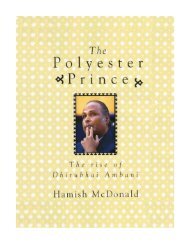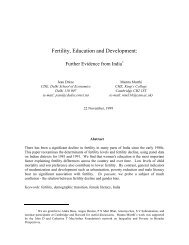In October 1977, Reliance had gone public, with a public offer of 2.8 million equityshares of Rs 10 each at par, taken from the holdings of Dhirubhai and his youngerbrother Nathubhai. With its shareholding thus broadened to meet listingrequirements, Reliance was listed on the stock exchanges in Bombay andAhmedabad in January 1978.<strong>The</strong>reafter Reliance expanded its equity base through frequent rights and bonusissues to shareholders, while financial institutions converted 20 per cent of theirloans into equity in September 1979. But it was through the use of convertibledebentures that Dhirubhai made his big splash in the capital markets. Indeed,Dhirubhai had anticipated Sen Gupta’s policy with the Series I issue of partiallyconvertible debentures by Reliance in October 1979, raising Rs 70 million.Reliance was not alone in trying the long disused instrument promoted by SenGupta. <strong>The</strong> Tata group’s automotive firm Telco raised Rs 230 million with a fullyconvertible issue in 1980, followed by the Gujarat Narmada Fertiliser Corp with a Rs430 million issue. But from late 1980 the issues of partially convertible debenturescame from Reliance in quick succession, raising Rs 108 million in September from itsSeries 11 and Rs 240 million from its Series 111 the next year, and Rs 500 millionfrom Series IV in April 1982. Dhirubhai capped that by obtaining from Sen Guptaclearance to do what should normally be legally impossible: converting the nonconvertibleportions of the four debenture issues into equity.By this method, dubbed a ‘brilliant and unconventional move’s by the magazine ‘<strong>The</strong>Economic Scene’s in a September 1984 cover story on Dhirubhai-Reliance was ableto chop Rs 735 million off its debt book in 1983, and turn it into comparativelymodest equity of Rs 103 million, while reserves were raised by Rs 632 million.Instead of an annual interest bill of Rs 96.5 million on debentures, the dividendburden from the extra equity was only around Rs 36 million. This transmutationallowed Reliance to continue raising more quasi-debt, with its E Series of partiallyconvertible debentures in October 1984 which raised another Rs 800 million.Sen Gupta denies that he was unduly permissive to Reliance, or that he everreceived any benefits from Dhirubhai such as share allotments. ‘In my firstencounter with him I had to say no,’ Sen Gupta recalled. With the third series ofdebentures, Dhirubhai had put in a request that the holders be entitled to renouncerights attached to their implicit share entitlements. Sen Gupta insisted that thedebentures were not shares until converted.But Reliance was highly persuasive. On another occasion, Sen Gupta rejected thepremium that Reliance was seeking to put on an issue, on the ground that projectedprofitability had not been indicated. Without a pro-forma balance sheet for thecurrent year an extension of results to date-it could not be accepted.It was 1 pm that day; Sen Gupta was due to fly that evening to Bombay for ameeting of his seven-member committee on capital issues the next morning.Obviously it would be impossible to have the paperwork ready for this meeting. Hetold Reliance.Coming out of the arrivals hall of Bombay Airport at 7 pm, Sen Gupta was met byaccountants from Reliance, and handed a copy of the pro-forma balance sheet andresults for each of the seven committee members. ‘I had no option but to take upthe matter at our meeting,’ Sen Gupta said. .
By the end of 1986, Dhirubhai was to raise an unprecedented Rs 9.4 billion from thepublic over eight years, including Rs 5 billion from one debenture issue alone. ‘In factthis one company, Reliance,’ wrote Sen Gupta, ‘made significant contributions to thegrowth of the debenture market in the country through its successive issues ofconvertible debentures, a new experiment in running a big business undertakingentirelyon the resources drawn from the public at large without being backed by anymultinational, large industrial houses, or without taking term- loans from financialinstitutions on a significant scale.It was not entirely true that Dhirubhai did not tap the banks, as we shall see, but hisheyday in the capital markets did coincide with the rise of what Indian businessmagazines came to call the, ‘equity cult’s and Dhirubhai can rightly claim some ofthe credit for it.Between 1980 and 1985, the number of Indians owning shares increased from lessthan one million to four million. Among those, the number of shareholders inReliance rose to more than one million by the end of 1985. It was by far the widestshareholder base of any Indian company - and, until the privatisation of majorutilities like British Telecom or Nippon Telephone & Telegraph, probably in the world.It was evidence of a popular following that made many politicians, especially inGuiarat where Dhirubhai had earned local hero status-think twice before denying himanything.Sen Gupta put the sharemarket craze down to the entry of three non-traditionalclasses of investors. One was the Indian middle class, who had forgotten about theirmisadventure in the stockmarket in the Second World War. Another was theexpatriate Indian communities, prospering rapidly in Britain, North America andSoutheast Asia after their miserable expulsion from East Africa in the 1960s, andaugmented by direct migrants qualifying for professional and skilled entry toadvanced economics. Since Pranab Mukherjee’s 1982 budget, these non-residentIndians or NRIs and their companies had been able to invest directly into Indianequities. <strong>The</strong> third class was the larger landowning farmers, prosperous after thehuge crop-yield increases of the Green Revolution during the 1960s and 1970s, whocontinued to enjoy tax exemption on their income.<strong>The</strong> equity cult spread from nearly 20 major exchanges. <strong>The</strong> premier bourse was thecentury-old Bombay Stock Exchange located in Dalal Street, one of the teemingnarrow streets of the city’s Old Fort district where brokers, businessmen,accountants and lawyers crammed into tiny offices in old stone buildings with theremnants of charming wooden and wrought-iron balconies.Although surmounted by a 28-storey office tower of cement, steel and glass, thetrading floor in the podium operated until the mid-1990s much as it had done in the19th century. Some computer monitors flickered on the periphery but no oneexpected them to keep up with the frenetic trading done by brawling, shouting,gesticulating ‘robbers’ in blue jackets, or with the thriving after-hours kerb marketwhere shares were traded informally.<strong>The</strong> paperwork was also miles behind the action. Share transactions were recordedon scraps of paper at brokers’ offices, but transfers were not necessarily lodged withcompany registrars immediately. Settlements came every second Friday, causing a
- Page 2: AcknowledgementsIntroduction: an in
- Page 7 and 8: several years. I sent off some clip
- Page 9 and 10: esearch led me into all corners of
- Page 11 and 12: A PERSUASIVE YOUNG BANIAAmong all t
- Page 13 and 14: proportion of these from Kathiawar.
- Page 15 and 16: looked far beyond their immediate p
- Page 17 and 18: which involved boycotting imported
- Page 19 and 20: One of the students was a fellow Mo
- Page 21 and 22: The outpost had been a punishment s
- Page 23 and 24: As he developed more familiarity wi
- Page 25 and 26: water and haven for international t
- Page 27 and 28: Junagadh named Rathibhai Muchhala a
- Page 29 and 30: eing ‘suite luxurious’ compared
- Page 31 and 32: Dhirubhai was again lucky in that,
- Page 33 and 34: A FIRST-CLASS FOUNTAINDhirubhai Amb
- Page 35 and 36: minority government in 1996, and se
- Page 37 and 38: Corporation of India. Soon afterwar
- Page 39 and 40: Over two years in the early 1970s,
- Page 41 and 42: captive market. The ‘Eleven Day W
- Page 43 and 44: GURU OF THE EQUITY CULTIndira Gandh
- Page 45: politicisation of the machinery Fro
- Page 49 and 50: Reliance made sure that a comment b
- Page 51 and 52: half-hour of panic just before the
- Page 53 and 54: politicians and bureaucrats. ‘It
- Page 55 and 56: Friends in the right PlacesThis was
- Page 57 and 58: act of parliament as far back as 19
- Page 59 and 60: control, and a very long and favour
- Page 61 and 62: in the Telegraph’s leader. Facing
- Page 63 and 64: In December 1983, Dhirubhai had hos
- Page 65 and 66: Pydhonic to sell his polyester and
- Page 67 and 68: give money to political parties. We
- Page 69 and 70: estimated demand of 80 000 tonnes o
- Page 71 and 72: support the big investment in domes
- Page 73 and 74: others. Orkay was accused of pledgi
- Page 75 and 76: corruption. On the backs of ordinar
- Page 77 and 78: Financial Express, had carried both
- Page 79 and 80: constant ridicule and demonisation.
- Page 81 and 82: inquiries overseas, the little-trav
- Page 83 and 84: conversion was allowed, the holding
- Page 85 and 86: The company’s shares had already
- Page 87 and 88: In a four-part article published ov
- Page 89 and 90: The case against Reliance had been
- Page 91 and 92: companies, possibly to help strengt
- Page 93 and 94: Nusli Wadia’s children). Pandit b
- Page 95 and 96: carrying a relentless, campaign of
- Page 97 and 98:
The committee asked Reliance at lea
- Page 99 and 100:
To clinch a prosecution under the F
- Page 101 and 102:
operators of the Indian havala trad
- Page 103 and 104:
While the law enforcers were closin
- Page 105 and 106:
the obligatory disclosures in the p
- Page 107 and 108:
On 5 December, the Central Excise a
- Page 109 and 110:
LETTING LOOSE A SCORPIONDhirubhai A
- Page 111 and 112:
identified himself as an inquiry ag
- Page 113 and 114:
But the CBI’s two investigating o
- Page 115 and 116:
had been booked into the hotel unde
- Page 117 and 118:
dismissing Rajiv and appointing ano
- Page 119 and 120:
extended and gruelling interrogatio
- Page 121 and 122:
BUSINESS AS USUALDhirubhai Ambani w
- Page 123 and 124:
udget for the year starting April 1
- Page 125 and 126:
asket from UTI (by value) were Lars
- Page 127 and 128:
on the Financial Times of London. A
- Page 129 and 130:
1988, two allied activists, journal
- Page 131 and 132:
But just as the opposing forces see
- Page 133 and 134:
had continued social meetings with
- Page 135 and 136:
they recorded Babaria calling Kirti
- Page 137 and 138:
arrests on 1 August. When a reporte
- Page 139 and 140:
After the initial appearance of Kir
- Page 141 and 142:
Though he could not avert the storm
- Page 143 and 144:
Dhirubhai’s new newspaper, launch
- Page 145 and 146:
and indifferent to the bloodshed in
- Page 147 and 148:
temple at Ayodhya, he put off the f
- Page 149 and 150:
arriving at Rajiv’s heavily guard
- Page 151 and 152:
Securities and Exchange Board of In
- Page 153 and 154:
The shouting continued for half an
- Page 155 and 156:
The 1991-92 boom helped Dhirubhai q
- Page 157 and 158:
Because of this burden, any other n
- Page 159 and 160:
the proceeds of the previous Euro-i
- Page 161 and 162:
The telephone licences covered near
- Page 163 and 164:
HOUSEKEEPING SECRETSOn 29 November
- Page 165 and 166:
compliant bank to give in return fo
- Page 167 and 168:
According to sources close to the M
- Page 169 and 170:
Merrill Lynch. Jain had meanwhile c
- Page 171 and 172:
put on its screens. On 29 November,
- Page 173 and 174:
1992 into the tax evasion aspects o
- Page 175 and 176:
At least one former fund manager, a
- Page 177 and 178:
and avoids a prosecution in court.
- Page 179 and 180:
Reliance could no longer look eithe
- Page 181 and 182:
other hand, the ANZ Grindlays bank




